Abstract
We have previously defined major histocompatibility complex (MHC) class II-restricted T-cell epitopes from the carboxy-terminal region of group A streptococcal type 5 M protein. In this report, T-cell responses to one of these epitopes have been characterized in detail. T-cell clones from recombinant M5-immunized mice and popliteal lymph node cells from peptide-immunized mice were used to show that sM5[300-319] is recognized in the context of I-A alleles of four of nine independent MHC class II haplotypes: I-Ad, I-Af, I-Ak, and I-As. This epitope was also recognized by both helper (Th2) and inflammatory (Th1) subsets of murine T cells. The I-Ad-restricted epitope recognized by BALB/c mice was mapped to the 12-amino-acid peptide sM5[308-319] and was shown to provide helper function for an immunoglobulin G anti-peptide antibody response in BALB/c mice. Anti-peptide antibody was shown to be specific for M5[304-315] but failed to recognize intact rM5, suggesting that the conformation of the epitope differed between peptide and protein. However, the results demonstrate that overlapping epitopes can be the focus for both immunoglobulin G antibodies and the T cells which augment their production. Comparison of the available sequences for M proteins indicated that the T-cell epitope within M5[300-319] was highly conserved between M types and hence may elicit helper function for protective antibody responses to a wide range of M types. T-cell epitopes from conserved regions of M proteins which are recognized in the context of multiple MHC haplotypes have potential for the design of multivalent streptococcal vaccines.
Full text
PDF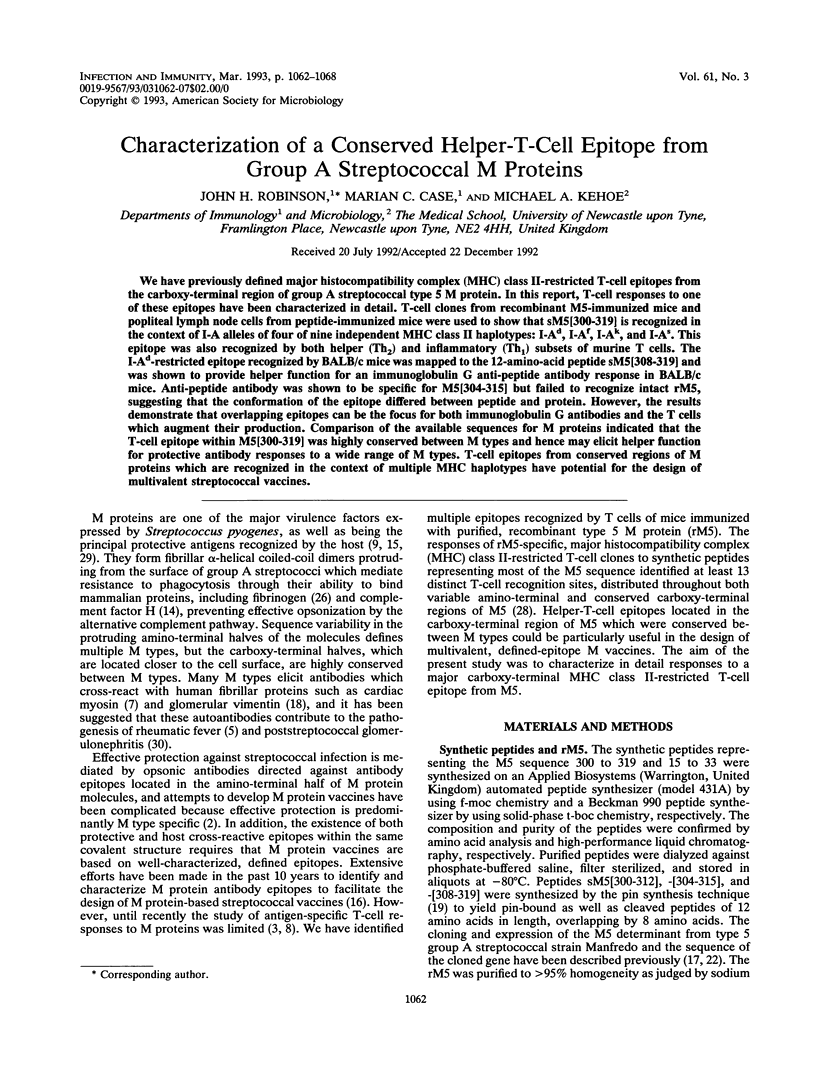
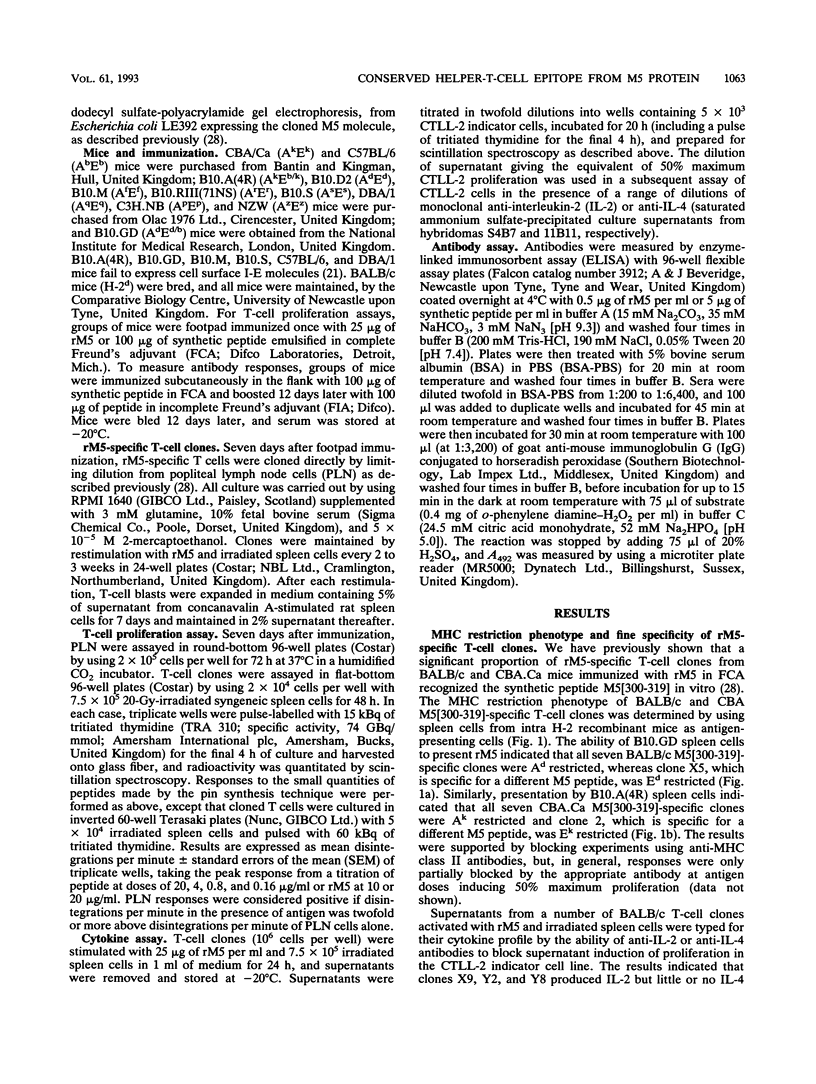
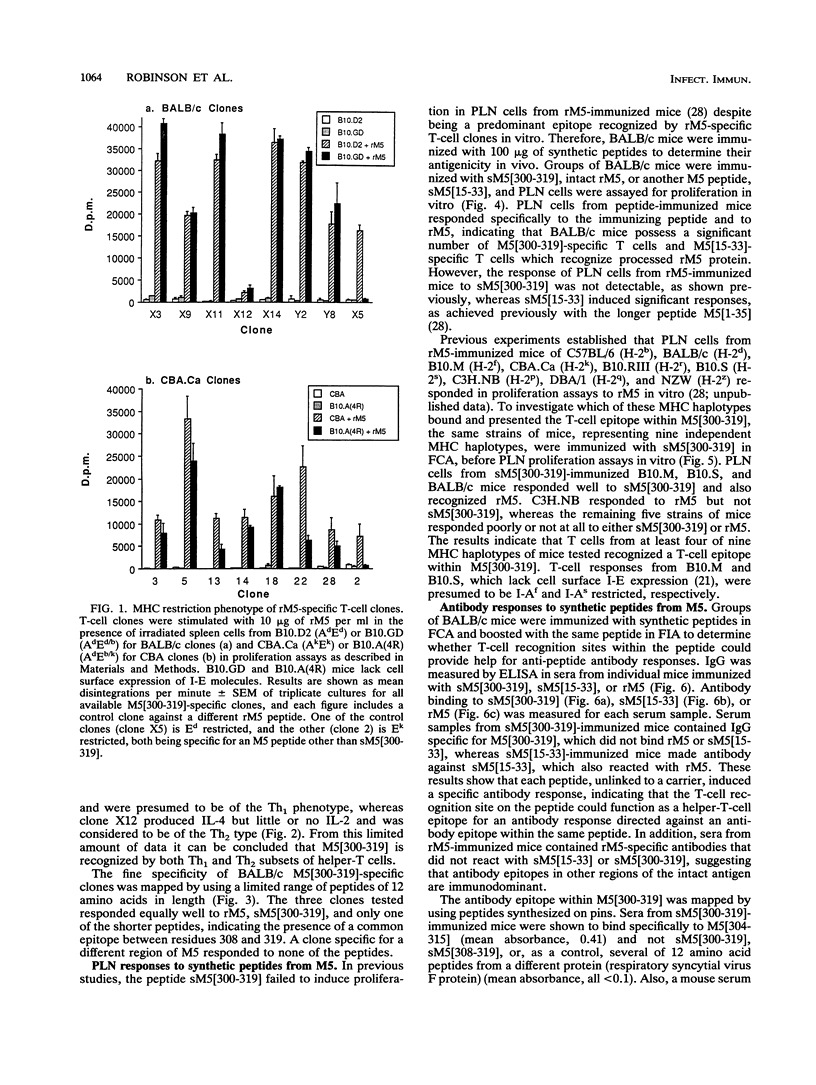
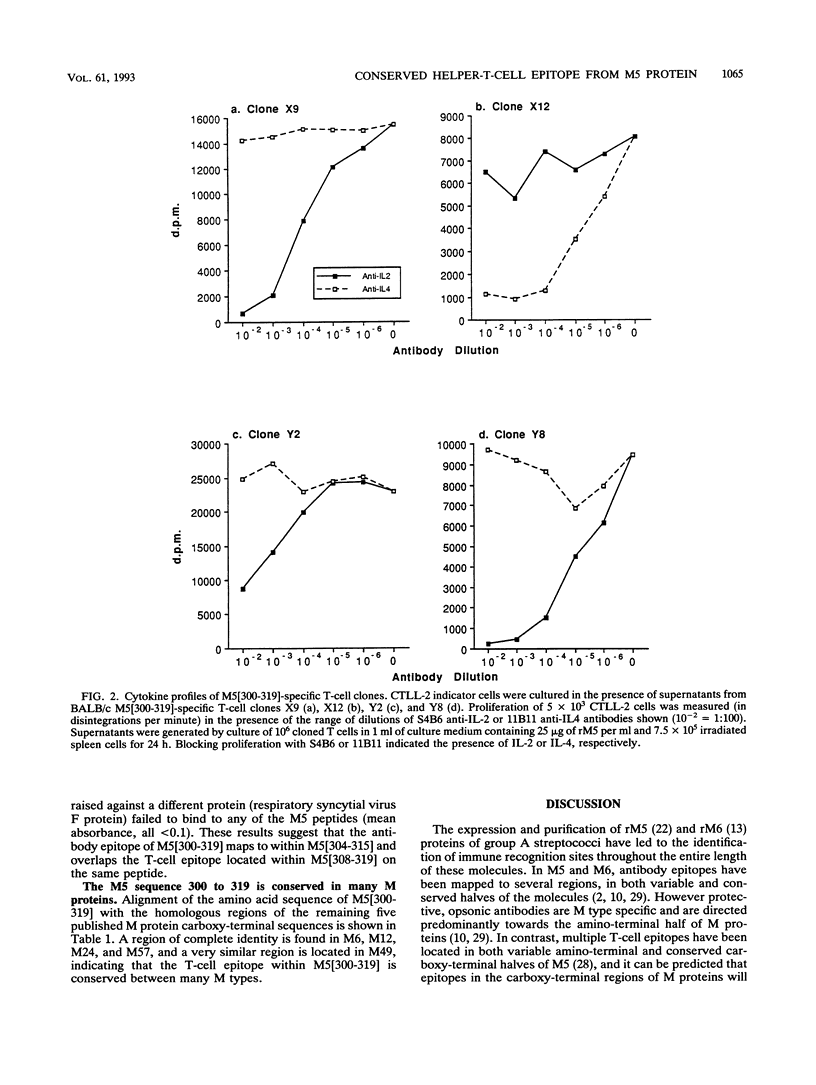
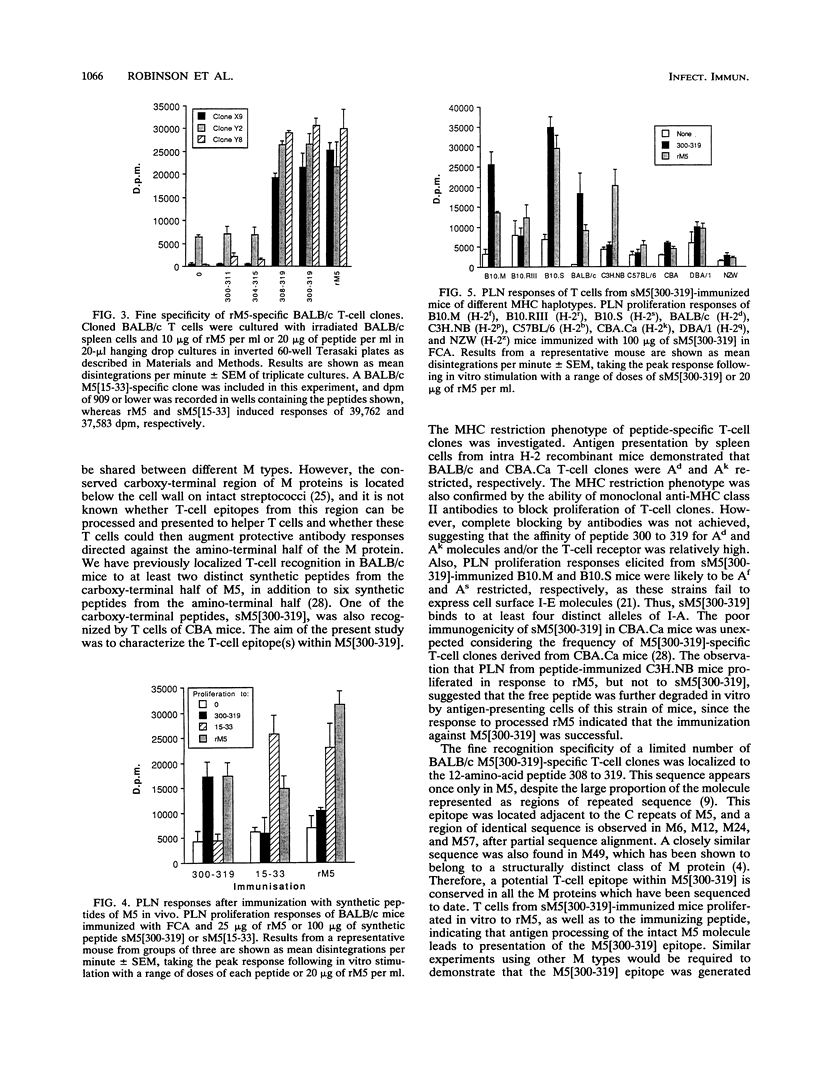
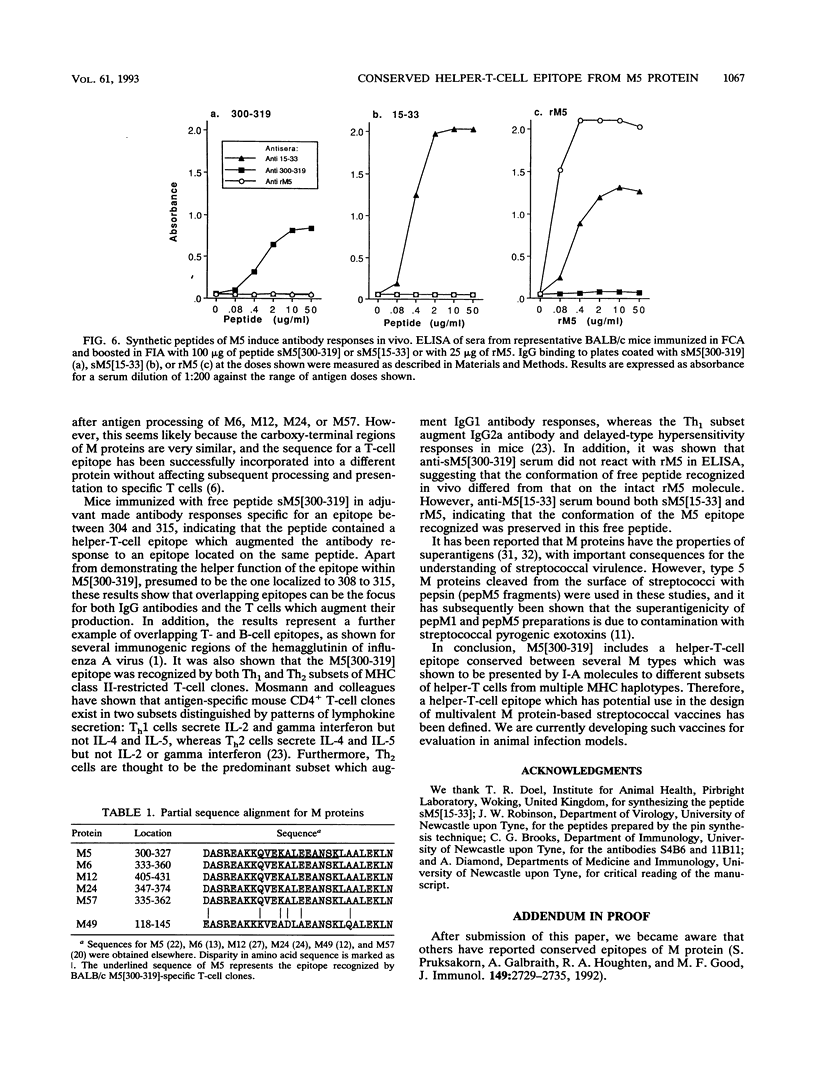
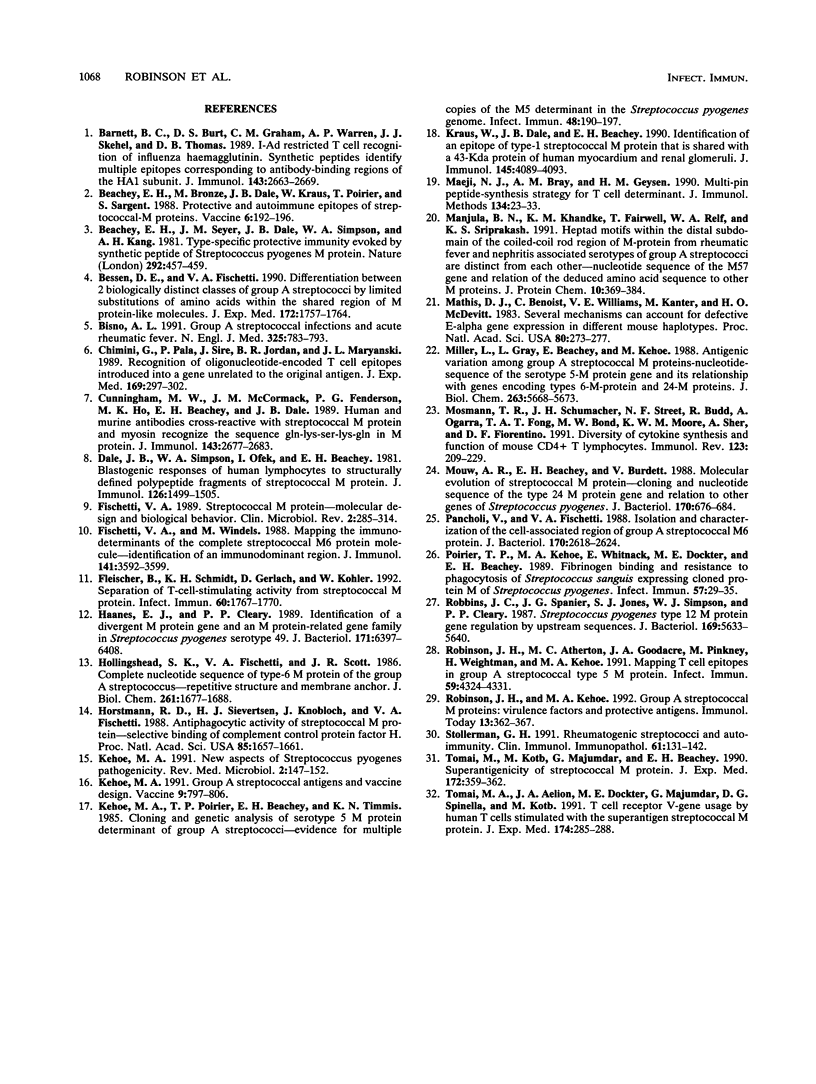
Selected References
These references are in PubMed. This may not be the complete list of references from this article.
- Barnett B. C., Burt D. S., Graham C. M., Warren A. P., Skehel J. J., Thomas D. B. I-Ad restricted T cell recognition of influenza hemagglutinin. Synthetic peptides identify multiple epitopes corresponding to antibody-binding regions of the HA1 subunit. J Immunol. 1989 Oct 15;143(8):2663–2669. [PubMed] [Google Scholar]
- Beachey E. H., Bronze M., Dale J. B., Kraus W., Poirier T., Sargent S. Protective and autoimmune epitopes of streptococcal M proteins. Vaccine. 1988 Apr;6(2):192–196. doi: 10.1016/s0264-410x(88)80027-6. [DOI] [PubMed] [Google Scholar]
- Beachey E. H., Seyer J. M., Dale J. B., Simpson W. A., Kang A. H. Type-specific protective immunity evoked by synthetic peptide of Streptococcus pyogenes M protein. Nature. 1981 Jul 30;292(5822):457–459. doi: 10.1038/292457a0. [DOI] [PubMed] [Google Scholar]
- Bessen D. E., Fischetti V. A. Differentiation between two biologically distinct classes of group A streptococci by limited substitutions of amino acids within the shared region of M protein-like molecules. J Exp Med. 1990 Dec 1;172(6):1757–1764. doi: 10.1084/jem.172.6.1757. [DOI] [PMC free article] [PubMed] [Google Scholar]
- Bisno A. L. Group A streptococcal infections and acute rheumatic fever. N Engl J Med. 1991 Sep 12;325(11):783–793. doi: 10.1056/NEJM199109123251106. [DOI] [PubMed] [Google Scholar]
- Chimini G., Pala P., Sire J., Jordan B. R., Maryanski J. L. Recognition of oligonucleotide-encoded T cell epitopes introduced into a gene unrelated to the original antigen. J Exp Med. 1989 Jan 1;169(1):297–302. doi: 10.1084/jem.169.1.297. [DOI] [PMC free article] [PubMed] [Google Scholar]
- Cunningham M. W., McCormack J. M., Fenderson P. G., Ho M. K., Beachey E. H., Dale J. B. Human and murine antibodies cross-reactive with streptococcal M protein and myosin recognize the sequence GLN-LYS-SER-LYS-GLN in M protein. J Immunol. 1989 Oct 15;143(8):2677–2683. [PubMed] [Google Scholar]
- Dale J. B., Simpson W. A., Ofek I., Beachey E. H. Blastogenic responses of human lymphocytes to structurally defined polypeptide fragments of streptococcal M protein. J Immunol. 1981 Apr;126(4):1499–1505. [PubMed] [Google Scholar]
- Fischetti V. A. Streptococcal M protein: molecular design and biological behavior. Clin Microbiol Rev. 1989 Jul;2(3):285–314. doi: 10.1128/cmr.2.3.285. [DOI] [PMC free article] [PubMed] [Google Scholar]
- Fischetti V. A., Windels M. Mapping the immunodeterminants of the complete streptococcal M6 protein molecule. Identification of an immunodominant region. J Immunol. 1988 Nov 15;141(10):3592–3599. [PubMed] [Google Scholar]
- Fleischer B., Schmidt K. H., Gerlach D., Köhler W. Separation of T-cell-stimulating activity from streptococcal M protein. Infect Immun. 1992 May;60(5):1767–1770. doi: 10.1128/iai.60.5.1767-1770.1992. [DOI] [PMC free article] [PubMed] [Google Scholar]
- Haanes E. J., Cleary P. P. Identification of a divergent M protein gene and an M protein-related gene family in Streptococcus pyogenes serotype 49. J Bacteriol. 1989 Dec;171(12):6397–6408. doi: 10.1128/jb.171.12.6397-6408.1989. [DOI] [PMC free article] [PubMed] [Google Scholar]
- Hollingshead S. K., Fischetti V. A., Scott J. R. Complete nucleotide sequence of type 6 M protein of the group A Streptococcus. Repetitive structure and membrane anchor. J Biol Chem. 1986 Feb 5;261(4):1677–1686. [PubMed] [Google Scholar]
- Horstmann R. D., Sievertsen H. J., Knobloch J., Fischetti V. A. Antiphagocytic activity of streptococcal M protein: selective binding of complement control protein factor H. Proc Natl Acad Sci U S A. 1988 Mar;85(5):1657–1661. doi: 10.1073/pnas.85.5.1657. [DOI] [PMC free article] [PubMed] [Google Scholar]
- Kehoe M. A. Group A streptococcal antigens and vaccine potential. Vaccine. 1991 Nov;9(11):797–806. doi: 10.1016/0264-410x(91)90216-s. [DOI] [PubMed] [Google Scholar]
- Kehoe M. A., Poirier T. P., Beachey E. H., Timmis K. N. Cloning and genetic analysis of serotype 5 M protein determinant of group A streptococci: evidence for multiple copies of the M5 determinant in the Streptococcus pyogenes genome. Infect Immun. 1985 Apr;48(1):190–197. doi: 10.1128/iai.48.1.190-197.1985. [DOI] [PMC free article] [PubMed] [Google Scholar]
- Kraus W., Dale J. B., Beachey E. H. Identification of an epitope of type 1 streptococcal M protein that is shared with a 43-kDa protein of human myocardium and renal glomeruli. J Immunol. 1990 Dec 15;145(12):4089–4093. [PubMed] [Google Scholar]
- Maeji N. J., Bray A. M., Geysen H. M. Multi-pin peptide synthesis strategy for T cell determinant analysis. J Immunol Methods. 1990 Nov 6;134(1):23–33. doi: 10.1016/0022-1759(90)90108-8. [DOI] [PubMed] [Google Scholar]
- Manjula B. N., Khandke K. M., Fairwell T., Relf W. A., Sriprakash K. S. Heptad motifs within the distal subdomain of the coiled-coil rod region of M protein from rheumatic fever and nephritis associated serotypes of group A streptococci are distinct from each other: nucleotide sequence of the M57 gene and relation of the deduced amino acid sequence to other M proteins. J Protein Chem. 1991 Aug;10(4):369–384. doi: 10.1007/BF01025251. [DOI] [PubMed] [Google Scholar]
- Mathis D. J., Benoist C., Williams V. E., 2nd, Kanter M., McDevitt H. O. Several mechanisms can account for defective E alpha gene expression in different mouse haplotypes. Proc Natl Acad Sci U S A. 1983 Jan;80(1):273–277. doi: 10.1073/pnas.80.1.273. [DOI] [PMC free article] [PubMed] [Google Scholar]
- Miller L., Gray L., Beachey E., Kehoe M. Antigenic variation among group A streptococcal M proteins. Nucleotide sequence of the serotype 5 M protein gene and its relationship with genes encoding types 6 and 24 M proteins. J Biol Chem. 1988 Apr 25;263(12):5668–5673. [PubMed] [Google Scholar]
- Mosmann T. R., Schumacher J. H., Street N. F., Budd R., O'Garra A., Fong T. A., Bond M. W., Moore K. W., Sher A., Fiorentino D. F. Diversity of cytokine synthesis and function of mouse CD4+ T cells. Immunol Rev. 1991 Oct;123:209–229. doi: 10.1111/j.1600-065x.1991.tb00612.x. [DOI] [PubMed] [Google Scholar]
- Mouw A. R., Beachey E. H., Burdett V. Molecular evolution of streptococcal M protein: cloning and nucleotide sequence of the type 24 M protein gene and relation to other genes of Streptococcus pyogenes. J Bacteriol. 1988 Feb;170(2):676–684. doi: 10.1128/jb.170.2.676-684.1988. [DOI] [PMC free article] [PubMed] [Google Scholar]
- Pancholi V., Fischetti V. A. Isolation and characterization of the cell-associated region of group A streptococcal M6 protein. J Bacteriol. 1988 Jun;170(6):2618–2624. doi: 10.1128/jb.170.6.2618-2624.1988. [DOI] [PMC free article] [PubMed] [Google Scholar]
- Poirier T. P., Kehoe M. A., Whitnack E., Dockter M. E., Beachey E. H. Fibrinogen binding and resistance to phagocytosis of Streptococcus sanguis expressing cloned M protein of Streptococcus pyogenes. Infect Immun. 1989 Jan;57(1):29–35. doi: 10.1128/iai.57.1.29-35.1989. [DOI] [PMC free article] [PubMed] [Google Scholar]
- Pruksakorn S., Galbraith A., Houghten R. A., Good M. F. Conserved T and B cell epitopes on the M protein of group A streptococci. Induction of bactericidal antibodies. J Immunol. 1992 Oct 15;149(8):2729–2735. [PubMed] [Google Scholar]
- Robbins J. C., Spanier J. G., Jones S. J., Simpson W. J., Cleary P. P. Streptococcus pyogenes type 12 M protein gene regulation by upstream sequences. J Bacteriol. 1987 Dec;169(12):5633–5640. doi: 10.1128/jb.169.12.5633-5640.1987. [DOI] [PMC free article] [PubMed] [Google Scholar]
- Robinson J. H., Atherton M. C., Goodacre J. A., Pinkney M., Weightman H., Kehoe M. A. Mapping T-cell epitopes in group A streptococcal type 5 M protein. Infect Immun. 1991 Dec;59(12):4324–4331. doi: 10.1128/iai.59.12.4324-4331.1991. [DOI] [PMC free article] [PubMed] [Google Scholar]
- Robinson J. H., Kehoe M. A. Group A streptococcal M proteins: virulence factors and protective antigens. Immunol Today. 1992 Sep;13(9):362–367. doi: 10.1016/0167-5699(92)90173-5. [DOI] [PubMed] [Google Scholar]
- Stollerman G. H. Rheumatogenic streptococci and autoimmunity. Clin Immunol Immunopathol. 1991 Nov;61(2 Pt 1):131–142. doi: 10.1016/s0090-1229(05)80019-4. [DOI] [PubMed] [Google Scholar]
- Tomai M. A., Aelion J. A., Dockter M. E., Majumdar G., Spinella D. G., Kotb M. T cell receptor V gene usage by human T cells stimulated with the superantigen streptococcal M protein. J Exp Med. 1991 Jul 1;174(1):285–288. doi: 10.1084/jem.174.1.285. [DOI] [PMC free article] [PubMed] [Google Scholar]
- Tomai M., Kotb M., Majumdar G., Beachey E. H. Superantigenicity of streptococcal M protein. J Exp Med. 1990 Jul 1;172(1):359–362. doi: 10.1084/jem.172.1.359. [DOI] [PMC free article] [PubMed] [Google Scholar]


